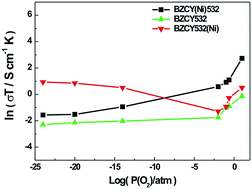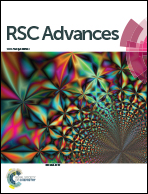The effect of NiO on the conductivity of BaZr0.5Ce0.3Y0.2O3−δ based electrolytes†
Abstract
The effects of NiO on the sintering behaviors, morphologies and conductivities of BaZr0.5Ce0.3Y0.2O3−δ (BZCY532) based electrolytes were systematically investigated. 1 wt% NiO powder was added by different methods during the sample preparation: (i) added during ball-milling before a powder mixture calcination (named BZCY(Ni)532), (ii) no NiO addition in the whole preparation procedure (named BZCY532) and (iii) added after a powder mixture calcination (named BZCY532(Ni)). The conductivities of these three kinds of dense BZCY532 ceramics were investigated in dry air, wet N2 and wet H2 atmospheres, respectively. Moreover, the electronic contributions to the total conductivities were also identified in a broad oxygen partial pressure range. According to the achieved results, it can be concluded that the dense BZCY(Ni)532 ceramics showed the best enhanced oxygen and proton conductivities, followed by the BZCY532(Ni) and BZCY532 ceramics. Furthermore, the BZCY(Ni)532 and BZCY532 ceramics showed a tiny electronic conductivity, when the testing temperatures were lower than 800 °C. However, the BZCY532(Ni) ceramics revealed an obvious electronic conduction when they were tested at temperatures of 600–800 °C. Therefore, it is preferable to add the NiO during powder preparation, which can lower the sintering temperature and also increase the conductivity of BZCY532-based electrolytes.



 Please wait while we load your content...
Please wait while we load your content...